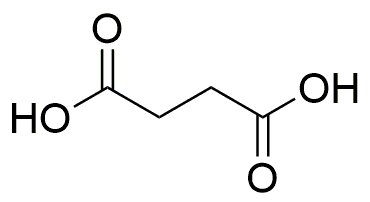Butanedioic acid is widely utilized in research focused on:
- Food Industry: It serves as a food additive, enhancing flavor and acidity in various products, particularly in the production of certain cheeses and beverages.
- Pharmaceuticals: This compound is used in the synthesis of various drugs, acting as a key intermediate in the production of active pharmaceutical ingredients (APIs).
- Polymer Production: Butanedioic acid is a precursor for the manufacture of biodegradable plastics, contributing to environmentally friendly materials that are gaining popularity in packaging.
- Agriculture: It is employed in the formulation of fertilizers and soil conditioners, helping to improve soil quality and enhance crop yields.
- Cosmetics: The compound is utilized in cosmetic formulations as a pH adjuster and stabilizer, ensuring product efficacy and safety for consumers.
General Information
Properties
Safety and Regulations
Applications
Butanedioic acid is widely utilized in research focused on:
- Food Industry: It serves as a food additive, enhancing flavor and acidity in various products, particularly in the production of certain cheeses and beverages.
- Pharmaceuticals: This compound is used in the synthesis of various drugs, acting as a key intermediate in the production of active pharmaceutical ingredients (APIs).
- Polymer Production: Butanedioic acid is a precursor for the manufacture of biodegradable plastics, contributing to environmentally friendly materials that are gaining popularity in packaging.
- Agriculture: It is employed in the formulation of fertilizers and soil conditioners, helping to improve soil quality and enhance crop yields.
- Cosmetics: The compound is utilized in cosmetic formulations as a pH adjuster and stabilizer, ensuring product efficacy and safety for consumers.
Documents
Safety Data Sheets (SDS)
The SDS provides comprehensive safety information on handling, storage, and disposal of the product.
Product Specification (PS)
The PS provides a comprehensive breakdown of the product’s properties, including chemical composition, physical state, purity, and storage requirements. It also details acceptable quality ranges and the product's intended applications.
Certificates of Analysis (COA)
Search for Certificates of Analysis (COA) by entering the products Lot Number. Lot and Batch Numbers can be found on a product’s label following the words ‘Lot’ or ‘Batch’.
*Catalog Number
*Lot Number
Certificates Of Origin (COO)
This COO confirms the country where the product was manufactured, and also details the materials and components used in it and whether it is derived from natural, synthetic, or other specific sources. This certificate may be required for customs, trade, and regulatory compliance.
*Catalog Number
*Lot Number
Safety Data Sheets (SDS)
The SDS provides comprehensive safety information on handling, storage, and disposal of the product.
DownloadProduct Specification (PS)
The PS provides a comprehensive breakdown of the product’s properties, including chemical composition, physical state, purity, and storage requirements. It also details acceptable quality ranges and the product's intended applications.
DownloadCertificates of Analysis (COA)
Search for Certificates of Analysis (COA) by entering the products Lot Number. Lot and Batch Numbers can be found on a product’s label following the words ‘Lot’ or ‘Batch’.
*Catalog Number
*Lot Number
Certificates Of Origin (COO)
This COO confirms the country where the product was manufactured, and also details the materials and components used in it and whether it is derived from natural, synthetic, or other specific sources. This certificate may be required for customs, trade, and regulatory compliance.


